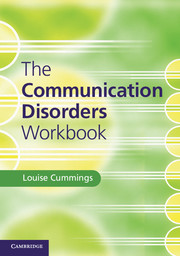Book contents
- Frontmatter
- Contents
- Preface
- Acknowledgements
- List of data analysis exercises
- Chapter 1 Introduction to communication disorders
- Chapter 2 Developmental speech disorders
- Chapter 3 Developmental language disorders
- Chapter 4 Communication disorders in mental illness
- Chapter 5 Acquired speech disorders
- Chapter 6 Acquired language disorders
- Chapter 7 Disorders of voice
- Chapter 8 Disorders of fluency
- Chapter 9 Hearing disorders
- Answers to questions and exercises
- Glossary
- References
- Index
- References
Chapter 2 - Developmental speech disorders
Published online by Cambridge University Press: 05 June 2014
- Frontmatter
- Contents
- Preface
- Acknowledgements
- List of data analysis exercises
- Chapter 1 Introduction to communication disorders
- Chapter 2 Developmental speech disorders
- Chapter 3 Developmental language disorders
- Chapter 4 Communication disorders in mental illness
- Chapter 5 Acquired speech disorders
- Chapter 6 Acquired language disorders
- Chapter 7 Disorders of voice
- Chapter 8 Disorders of fluency
- Chapter 9 Hearing disorders
- Answers to questions and exercises
- Glossary
- References
- Index
- References
Summary
For a significant number of children, the acquisition of speech in the developmental period does not occur along normal lines. During embryonic development, a range of craniofacial malformations may occur, leading to structural defects of the anatomical structures which are necessary for speech production. For example, the tissues of the palate and upper lip may fail to fuse during the first trimester of pregnancy, resulting in a cleft of the lip and hard and soft palates. This craniofacial anomaly may occur in isolation or alongside a number of other defects as part of a syndrome (e.g. Pierre Robin syndrome). Other syndromes in which there is abnormal development of the organs of articulation include a small mandible (micrognathia) in Treacher Collins syndrome and abnormal palatal morphology in Down's syndrome. In all these cases, speech acquisition is likely to be compromised to a greater or lesser degree.
Aside from structural defects, the development of speech can also be compromised on account of a neurological impairment. A speech disorder known as dysarthria results when there is damage of the motor centres in the brain and/or any of the pathways which transmit nervous impulses to the muscles of the articulators. The most common cause of developmental dysarthria is cerebral palsy. The child with congenital cerebral palsy has brain damage, often of unknown origin. In cases where the cause of this damage is known, aetiologies can include infections (e.g. maternal rubella), birth anoxia, prenatal exposure to alcohol and cocaine, and traumatic brain injury. Other, less common causes of developmental dysarthria include Duchenne's muscular dystrophy and genetic syndromes (e.g. Down's syndrome). The severity of the speech disorder in dysarthria can range from mild to severe. In the former case, there may be a negligible impact on the intelligibility of speech. In the latter case, speech may be so unintelligible that an alternative means of communication must be found for the client. The child with developmental dysarthria may also have swallowing problems (dysphagia). These problems are also assessed and treated by speech and language therapists.
- Type
- Chapter
- Information
- The Communication Disorders Workbook , pp. 10 - 22Publisher: Cambridge University PressPrint publication year: 2014



